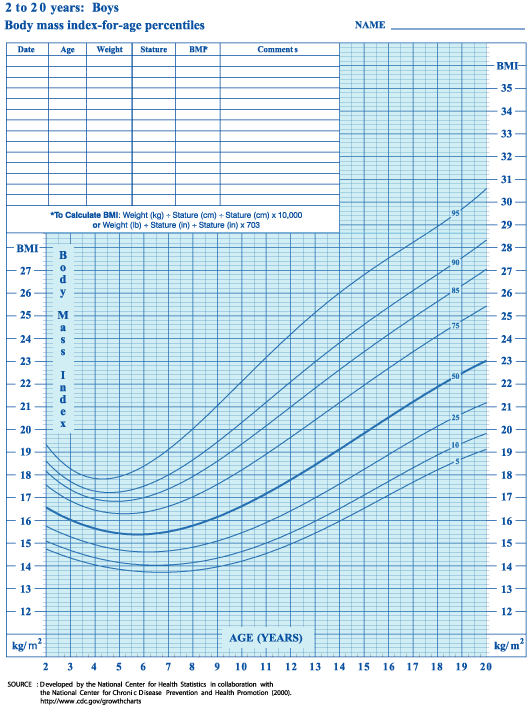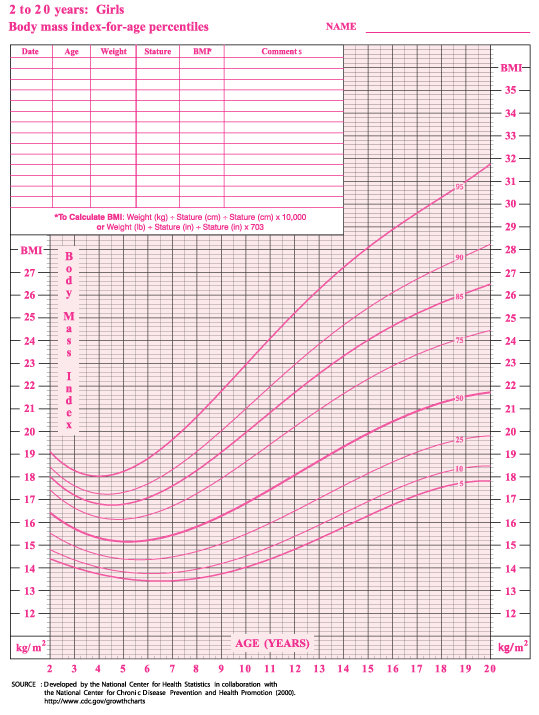
Contents
| WV | DHHR | BPH | OEHP | HSC |
Obesity:
Facts, Figures, Guidelines
Section One - continued
U.S. OBESITY PREVALENCE
Obesity Prevalence among Adults. The United States has the unwanted distinction of leading the way in obesity prevalence. The National Center for Health Statistics (NCHS), CDC, used data from the National Health Examination Survey (NHES I: 1960-62) and the National Health and Nutrition Examination Surveys I, II, and III (NHANES I: 1971-74; NHANES II: 1976-80; NHANES III: 1988-94) to compare prevalences of overweight and obesity among the nation's adults over nearly half a century (29). The researchers used the BMI categories listed on page 6. Overall, the
Body Mass Chart
Weight x Height
| Under Weight | Healthy Weight | Over Weight | Obese |
| BMI | Height | ||||||||||||||||||
|---|---|---|---|---|---|---|---|---|---|---|---|---|---|---|---|---|---|---|---|
| 58 | 59 | 60 | 61 | 62 | 63 | 64 | 65 | 66 | 67 | 68 | 69 | 70 | 71 | 72 | 73 | 74 | 75 | 76 | |
| Weight | 4'10" | 4'11" | 5'0" | 5'1" | 5'2" | 5'3" | 5'4" | 5'5" | 5'6" | 5'7" | 5'8" | 5'9" | 5'10' | 5'11" | 6'0" | 6'1" | 6'2" | 6'3" | 6'4" |
| 100 | 21 | 20 | 20 | 19 | 18 | 18 | 17 | 17 | 16 | 16 | 15 | 15 | 14 | 14 | 14 | 13 | 13 | 13 | 12 |
| 105 | 22 | 21 | 21 | 20 | 19 | 18 | 18 | 18 | 17 | 16 | 16 | 16 | 15 | 15 | 14 | 14 | 14 | 13 | 13 |
| 110 | 23 | 22 | 22 | 21 | 20 | 20 | 19 | 18 | 18 | 17 | 17 | 16 | 16 | 15 | 15 | 15 | 14 | 14 | 13 |
| 115 | 24 | 23 | 23 | 22 | 21 | 20 | 20 | 19 | 19 | 18 | 18 | 17 | 17 | 16 | 16 | 15 | 15 | 14 | 14 |
| 120 | 25 | 24 | 23 | 23 | 22 | 51 | 21 | 20 | 19 | 19 | 18 | 18 | 17 | 17 | 16 | 16 | 15 | 15 | 15 |
| 125 | 26 | 25 | 24 | 24 | 23 | 52 | 22 | 21 | 20 | 20 | 19 | 18 | 18 | 17 | 17 | 17 | 16 | 16 | 15 |
| 130 | 27 | 26 | 25 | 25 | 24 | 23 | 22 | 22 | 21 | 20 | 20 | 19 | 19 | 18 | 18 | 17 | 17 | 16 | 16 |
| 135 | 28 | 27 | 26 | 26 | 25 | 24 | 23 | 23 | 22 | 21 | 21 | 20 | 19 | 19 | 18 | 18 | 17 | 17 | 16 |
| 140 | 29 | 28 | 27 | 27 | 26 | 25 | 24 | 23 | 23 | 22 | 21 | 21 | 20 | 20 | 19 | 19 | 18 | 18 | 17 |
| 145 | 30 | 29 | 28 | 27 | 27 | 26 | 25 | 24 | 23 | 23 | 22 | 21 | 21 | 20 | 20 | 19 | 19 | 18 | 18 |
| 150 | 31 | 30 | 29 | 28 | 27 | 27 | 26 | 25 | 24 | 24 | 23 | 22 | 22 | 21 | 20 | 20 | 19 | 19 | 18 |
| 155 | 32 | 31 | 30 | 29 | 28 | 28 | 27 | 26 | 25 | 24 | 24 | 23 | 22 | 22 | 21 | 20 | 20 | 19 | 19 |
| 160 | 33 | 32 | 31 | 30 | 29 | 28 | 28 | 27 | 26 | 25 | 24 | 24 | 23 | 22 | 22 | 21 | 21 | 20 | 20 |
| 165 | 35 | 33 | 32 | 31 | 30 | 29 | 28 | 28 | 27 | 26 | 25 | 24 | 24 | 23 | 22 | 22 | 21 | 21 | 20 |
| 170 | 36 | 34 | 33 | 32 | 31 | 30 | 29 | 28 | 27 | 27 | 26 | 25 | 24 | 24 | 23 | 22 | 22 | 21 | 21 |
| 175 | 37 | 35 | 34 | 33 | 32 | 31 | 30 | 29 | 28 | 27 | 27 | 26 | 25 | 24 | 24 | 23 | 23 | 22 | 21 |
| 180 | 38 | 36 | 35 | 34 | 33 | 32 | 31 | 30 | 29 | 28 | 27 | 27 | 26 | 25 | 24 | 24 | 23 | 23 | 22 |
| 185 | 39 | 37 | 36 | 35 | 34 | 33 | 32 | 31 | 30 | 29 | 28 | 27 | 27 | 26 | 25 | 24 | 24 | 23 | 23 |
| 190 | 40 | 38 | 37 | 36 | 35 | 34 | 33 | 32 | 31 | 30 | 29 | 28 | 27 | 27 | 26 | 25 | 24 | 24 | 23 |
| 195 | 41 | 39 | 38 | 37 | 36 | 35 | 34 | 33 | 32 | 31 | 30 | 29 | 28 | 27 | 27 | 26 | 25 | 24 | 24 |
| 200 | 42 | 40 | 39 | 38 | 37 | 36 | 34 | 33 | 32 | 31 | 30 | 30 | 29 | 28 | 27 | 26 | 26 | 25 | 24 |
| 205 | 43 | 41 | 40 | 39 | 38 | 36 | 35 | 34 | 33 | 32 | 31 | 30 | 29 | 29 | 28 | 27 | 26 | 26 | 25 |
| 210 | 44 | 43 | 41 | 40 | 38 | 37 | 36 | 35 | 34 | 33 | 32 | 31 | 30 | 29 | 29 | 28 | 27 | 26 | 26 |
| 215 | 45 | 44 | 42 | 41 | 39 | 38 | 37 | 36 | 35 | 34 | 33 | 32 | 31 | 30 | 29 | 28 | 28 | 27 | 26 |
| 220 | 46 | 45 | 43 | 42 | 40 | 39 | 38 | 37 | 36 | 35 | 34 | 33 | 32 | 31 | 30 | 29 | 28 | 28 | 27 |
| 225 | 47 | 46 | 44 | 43 | 41 | 40 | 39 | 38 | 36 | 35 | 34 | 33 | 32 | 31 | 31 | 30 | 29 | 28 | 27 |
| 230 | 48 | 47 | 45 | 44 | 42 | 41 | 40 | 38 | 37 | 36 | 35 | 34 | 33 | 32 | 31 | 30 | 30 | 29 | 28 |
| 235 | 49 | 48 | 46 | 44 | 43 | 42 | 40 | 39 | 38 | 37 | 36 | 35 | 34 | 33 | 32 | 31 | 30 | 29 | 29 |
| 240 | 50 | 49 | 47 | 45 | 44 | 43 | 41 | 40 | 39 | 38 | 37 | 36 | 35 | 34 | 33 | 32 | 31 | 30 | 29 |
| 245 | 51 | 50 | 48 | 46 | 45 | 43 | 42 | 41 | 40 | 38 | 37 | 36 | 35 | 34 | 33 | 32 | 32 | 31 | 30 |
| 250 | 52 | 51 | 49 | 47 | 46 | 44 | 43 | 42 | 40 | 39 | 38 | 37 | 36 | 35 | 34 | 33 | 32 | 31 | 30 |
| 255 | 53 | 52 | 50 | 48 | 47 | 45 | 44 | 43 | 41 | 40 | 39 | 38 | 37 | 36 | 35 | 34 | 33 | 32 | 31 |
| 260 | 54 | 53 | 51 | 49 | 48 | 46 | 45 | 43 | 42 | 41 | 40 | 38 | 37 | 36 | 35 | 34 | 33 | 33 | 32 |
| 265 | 56 | 54 | 52 | 50 | 49 | 47 | 46 | 44 | 43 | 42 | 40 | 39 | 38 | 37 | 36 | 35 | 34 | 33 | 32 |
| 270 | 57 | 55 | 53 | 51 | 49 | 48 | 46 | 45 | 44 | 42 | 41 | 40 | 39 | 38 | 37 | 36 | 35 | 34 | 33 |
| 275 | 58 | 56 | 54 | 52 | 50 | 49 | 47 | 46 | 44 | 43 | 42 | 41 | 40 | 38 | 37 | 36 | 35 | 34 | 34 |
| 280 | 59 | 57 | 55 | 53 | 51 | 50 | 48 | 47 | 45 | 44 | 43 | 41 | 40 | 39 | 38 | 37 | 36 | 35 | 34 |
| 285 | 60 | 58 | 56 | 54 | 52 | 51 | 49 | 48 | 46 | 45 | 43 | 42 | 41 | 40 | 39 | 38 | 37 | 36 | 35 |
| 290 | 61 | 59 | 57 | 55 | 53 | 51 | 50 | 48 | 47 | 46 | 44 | 43 | 42 | 41 | 39 | 38 | 37 | 36 | 35 |
| 295 | 62 | 60 | 58 | 56 | 54 | 52 | 51 | 49 | 48 | 46 | 45 | 44 | 42 | 41 | 40 | 39 | 38 | 37 | 36 |
| 300 | 63 | 61 | 59 | 57 | 55 | 53 | 52 | 50 | 49 | 47 | 46 | 44 | 43 | 42 | 41 | 40 | 39 | 38 | 37 |
GROWTH CHARTS FOR CHILDREN AND ADOLESCENTS age-adjusted prevalence of overweight among adults aged 20-74 changed little over the time period (NHES I: 30.5%; NHANES I: 32.0%; NHANES II: 31.5%: and NHANES III: 32%). Obesity prevalence (BMI 30.0+), however, increased dramatically between NHANES II and NHANES III (NHES I: 12.8%: NHANES I: 14.1%; NHANES II: 14.5%; and NHANES III: 22.5%). The trends were consistent for all age, gender, and racial groups.
Growth Charts for Children and Adolescents
In 2000, the BRFSS (18) estimated a median obesity prevalence of 20.4% among adults, a slightly lower prevalence than that from NHANES III due to the inclusion of adults aged 18-19 and 75+, two groups traditionally less likely to be overweight or obese2. Overweight (BMI 25.0-29.9) was estimated at 36.7%, leaving only 42.9% of adult Americans not at risk for health problems related to excess weight. In West Virginia, the obesity prevalence in 2000 was 23.2%, 5th highest in the nation. Another 36.5% of adults were overweight (19).
Overweight Prevalence among Children and Adolescents. The number of overweight children and adolescents, i.e., those with a BMI of equal to or greater than the 95th percentile for children of the same age and sex, increased by 100% between NHANES II in 1980 and NHANES III in 1994 (31). According to NHANES III data, approximately 14% of children in the U.S. were overweight at the beginning of the 1990s, increasing to about one in five by adolescence (32), and preliminary findings from NHANES IV suggest that childhood overweight continues to increase (31).
Strauss and Pollack analyzed data from the National Longitudinal Survey of Youth (NLSY) to ascertain trends in overweight prevalence among 8,270 U.S. children aged four to 12 in 1986 who were followed until 1998. The researchers examined overweight by sex, race/ethnicity (African American, Hispanic, and non-Hispanic white), family income level, and region of residence. Their findings showed that overweight increased from 1986-1998 among all demographic variables studied. The largest increases, however, occurred among boys, African Americans, Hispanics, and children living in the southern states (33). Over the study period, overweight increased more than 120% among African Americans and Hispanics and by more than 50% among white children. They also found that the relative weight of overweight children also increased, indicating that the severity as well as the prevalence of overweight has increased. The racial and ethnic disparities were found to remain even when controlling for family income. The same general trends appeared when the researchers examined those children at risk for overweight (BMI between the 85th and 95th percentiles).
2While NHANES weight and height were measured by health professionals, BRFSS data are self reported, and several studies have found that participants in self-reported studies tend to underestimate their weight and overestimate their height; thus, the true rates of obesity are likely to be underestimated (30). In addition, persons without telephones are not surveyed through BRFSS. These persons are likely of lower socioeconomic status, a demographic factor associated with obesity. Return To Text
Continue Section One:

